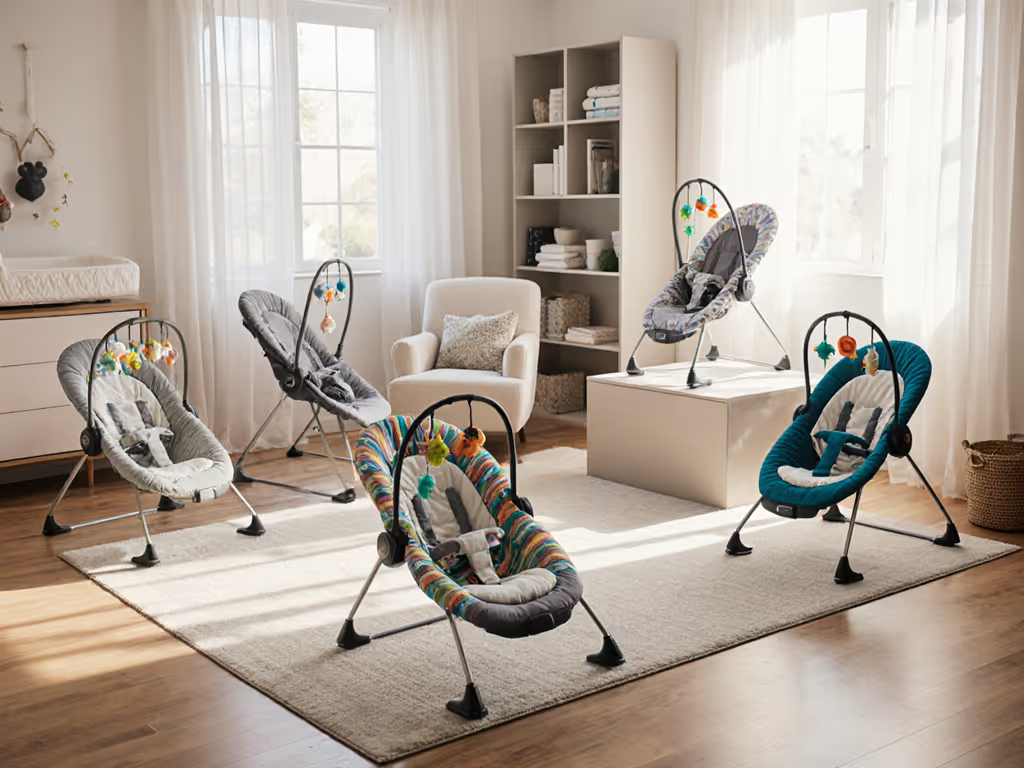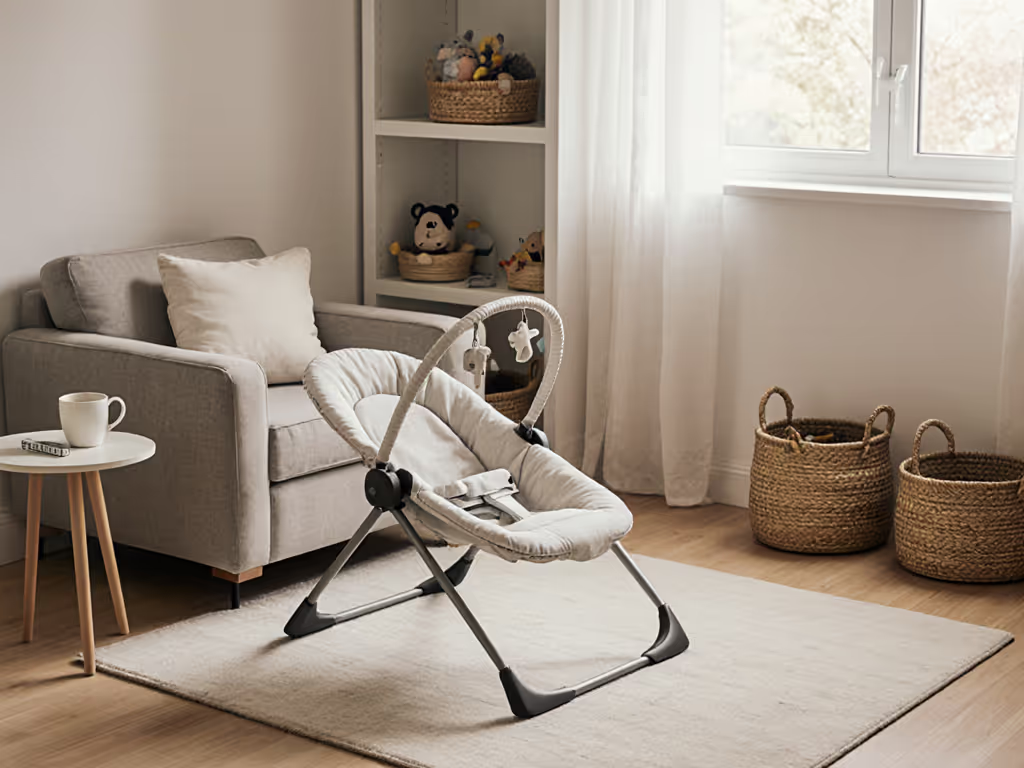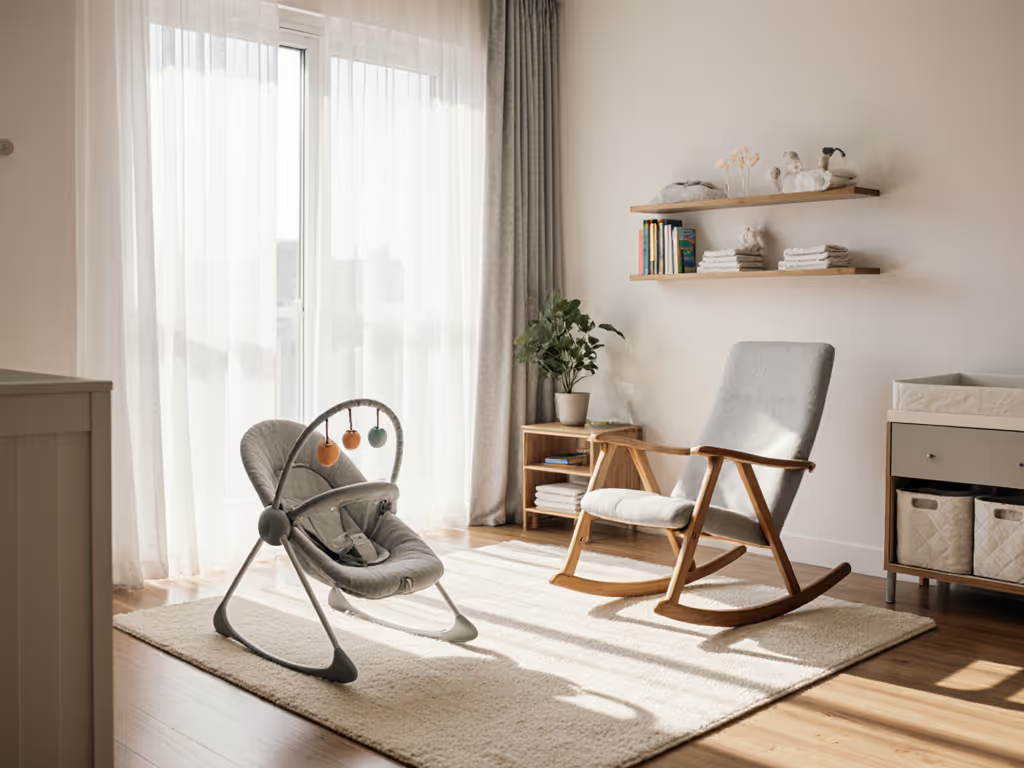
Space Saving Bouncer Tips for Maximizing Small Spaces

Did you know that the right baby bouncer placement can reduce household accidents by almost 40 percent? Creating a cozy, organized space for your little one is not just about looks. Parents need quick access, peace of mind, and a room that feels as open as possible even when baby gear is everywhere. Discover practical steps for choosing the best spot, selecting a compact model, and optimizing safety without sacrificing comfort.
Quick Summary
| Key Point | Explanation |
|---|---|
| 1. Measure your space for the bouncer | Ensure at least 3 square feet around the bouncer for safety and movement, avoiding high traffic areas. |
| 2. Choose compact bouncer models wisely | Look for space-saving features like folding designs and lightweight construction to fit limited living spaces. |
| 3. Establish a clutter-free zone around the bouncer | Clear at least 3 square feet of space around the bouncer to prevent tripping hazards and promote safety. |
| 4. Follow installation and storage guidelines | Read instructions carefully, practice setup, and store the bouncer in a clean, accessible place when not in use. |
| 5. Conduct daily safety checks | Inspect straps and structure daily to ensure stability and comfort for your baby during use. |
Step 1: Assess Room Dimensions for Optimal Placement
Finding the perfect spot for your bouncer is like solving a mini spatial puzzle. You want a location that maximizes safety, convenience, and space efficiency without making your room feel cluttered.
Start by grabbing a tape measure and mapping out your available floor space. Look for areas away from high traffic zones like doorways or hallways where someone might accidentally bump into the bouncer. Aim for a clear zone of at least 3 square feet around the bouncer for comfortable movement.
Measure the exact dimensions of your bouncer and compare them against potential placement areas. Some compact models are as small as 24 inches wide while others might require up to 36 inches of floor space. Check the height clearance too remember that bouncers typically stand 18 to 24 inches tall.
Pro Tip: Place the bouncer near an electrical outlet if it requires battery charging or has electronic features like vibration or music functions.
Consider the room's overall layout. Proximity to your primary seating area lets you keep an eye on your little one while giving you a moment to rest. Avoid placing the bouncer near windows drafts heating vents or direct sunlight which could make your baby uncomfortable.
Your next step will involve understanding weight distribution and ensuring a completely stable surface for safe bouncer placement. Get ready to create the perfect little nest for your infant.
Step 2: Compare Compact Bouncer Models for Best Fit
Not all baby bouncers are created equal especially when you are working with limited living space. Your mission is to find a compact model that meets your specific needs without overwhelming your home.
Start by looking for bouncers with smart design features that prioritize space efficiency. The BabyBjörn Balance Bouncer stands out as an excellent option. Its ergonomic design and ability to fold flat make it a top contender for small spaces. Another strong choice is the Ergobaby Evolve 3 in 1 Bouncer which offers three recline positions and can also fold completely flat for storage.
When comparing models focus on key space saving attributes. Look for bouncers that offer:
- Compact folding mechanisms
- Lightweight construction
- Minimal footprint
- Easy storage options
Pro Tip: Check the specific folded dimensions. A bouncer that claims to be compact might still be bulky when collapsed.
Consider your specific living situation. Apartment dwellers might prioritize ultra slim models while those with slightly more room can opt for slightly larger options with additional features. Pay attention to weight limits weight of the bouncer itself and overall stability.
Weight distribution and floor space requirements are critical. Some compact models can support babies up to 20 pounds while maintaining a small profile. Your goal is finding that perfect balance between functionality comfort and space efficiency.
Here's a comparison of popular compact bouncer models and their key space-saving features:
| Model | Folded Dimensions | Weight | Special Features |
|---|---|---|---|
| BabyBjörn Balance Bouncer | 35 x 15 x 4 in | 4.6 lbs | Folds flat<br>Ergonomic design |
| Ergobaby Evolve 3 in 1 | 32 x 16 x 5 in | 8.0 lbs | Three recline positions<br>Folds flat |
| Fisher-Price Infant-to-Toddler | 24 x 18 x 4 in | 6.6 lbs | Lightweight<br>Machine washable seat |
| Graco DuetConnect LX | 28 x 18 x 7 in | 11 lbs | Two-in-one swing & bouncer<br>Compact fold |
With these comparisons in hand you are now ready to select a bouncer that will seamlessly integrate into your living space without creating unnecessary clutter.

Step 3: Organize Surroundings to Minimize Clutter
Clearing space around your baby bouncer isn't just about aesthetics it's about creating a safe functional environment for your little one. Think of this as your mission to transform chaotic corners into organized sanctuaries of baby comfort.
Start by establishing a clear perimeter around your bouncer. Remove loose rugs throw pillows electrical cords or any items that could potentially create a tripping hazard. A minimum of 3 square feet of clear space ensures safe movement and prevents accidental bumps or falls.
Vertical storage becomes your new best friend. Install wall mounted shelves or hanging organizers to keep baby essentials like wipes blankets and small toys within reach but off the floor. Look for slim profile storage solutions that can slide into narrow spaces between furniture or mounted directly above your bouncer area.
Pro Tip: Use clear plastic bins with labels to create an organized system that allows quick access without creating visual chaos.
Consider multipurpose furniture that offers hidden storage. Ottoman seats with internal compartments or side tables with drawers can help you stash baby gear without cluttering your living space. Choose pieces that blend seamlessly with your existing decor while providing practical storage solutions.
Rotate your baby's toys and accessories regularly. Keep only what you need immediately accessible and store the rest in designated closet spaces. This approach prevents overwhelming visual clutter and makes your space feel more intentional and calm.
Your next goal is understanding weight distribution and creating a stable environment that maximizes both safety and space efficiency. Prepare to transform your living area into a streamlined baby friendly zone.
Step 4: Install and Store Your Bouncer Efficiently
Mastering the art of bouncer installation and storage can save you precious time and frustration. Your goal is to create a seamless system that makes setting up and putting away your baby gear a breeze.
When installing your bouncer start by carefully reading the manufacturer's instructions. Some models like the BabyBjörn Balance Bouncer are designed with intuitive folding mechanisms that make setup incredibly straightforward. Look for bouncers with quick release buttons or simple folding systems that don't require complex maneuvers.
Check the surface where you plan to place the bouncer. Ensure it is completely flat and stable with no risk of tipping. Hardwood floors tile or low pile carpets work best. Avoid uneven surfaces or areas with potential wobbling that could compromise your baby's safety.
Pro Tip: Practice folding and unfolding your bouncer a few times before your baby arrives. This helps you become familiar with the mechanism and saves time during those hectic early weeks.
Storage is where compact design truly shines. The Ergobaby Evolve 3 in 1 Bouncer exemplifies smart storage solutions by folding completely flat. When not in use slide the bouncer into a closet behind a door or under a bed. Always store in a clean dry area away from direct sunlight to maintain the material's integrity.
Establish a consistent storage routine. After each use wipe down the bouncer clean and immediately fold it away. This prevents clutter buildup and ensures your bouncer remains in top condition. Create a designated storage spot that is easily accessible but out of your main living area.
Your next steps involve understanding the nuanced details of bouncer maintenance and creating a smooth workflow for daily use.
Step 5: Verify Safety and Accessibility in Daily Use
Daily bouncer safety goes beyond initial setup. It requires constant vigilance and proactive checks to ensure your baby remains secure and comfortable throughout every use.
Begin with a systematic daily inspection routine. Before placing your baby in the bouncer examine all connection points straps and structural elements for any signs of wear tear or potential weakness. Look for fraying fabric loose stitching or unexpected movement in the frame that could compromise stability.
Test the bouncer's stability by gently pressing different areas and observing how it responds. It should feel firm and resist unexpected tilting. Check that all locking mechanisms engage completely and that the base remains completely level on your chosen surface. Uneven surfaces can create subtle risks that might not be immediately apparent.
Pro Tip: Perform a weekly comprehensive safety check where you thoroughly inspect every component and test weight distribution more extensively.
Accessibility means more than just physical placement. Consider your ability to quickly reach and interact with your baby. Position the bouncer where you can easily make eye contact adjust positioning or comfort your little one without significant movement. This means avoiding areas with complex navigation or potential obstacles.
Monitor your baby's comfort and reaction to the bouncer. Some infants might develop preferences or discomfort in certain positions. Watch for signs of restlessness uneven weight distribution or potential strain. A safe bouncer adapts to your baby's changing needs and provides consistent support.
Your final step involves developing an intuitive understanding of your specific bouncer's unique characteristics and your baby's individual comfort requirements.
Maximize Your Small Space with the Perfect Baby Bouncer
Struggling to find a safe and comfortable spot for your baby bouncer in a small home can feel overwhelming. You want to keep your living area clutter-free while ensuring your little one enjoys every bounce in a secure, stable environment. This article highlights crucial pain points like limited floor space, stability concerns, and accessibility. It also stresses the importance of smart placement and storage strategies that prioritize safety and ease of use.
If you are ready to take the guesswork out of choosing the ideal compact bouncer designed to fit your living space and daily needs visit Bouncer Lab. Our comprehensive guides and detailed reviews focus on space-saving designs, safety features, and practical storage tips to help you confidently select the right model. Discover top picks like ergonomic foldable bouncers and lightweight options that balance comfort with minimal footprint. Start creating a calm and organized nursery area today by exploring our expert advice at Bouncer Lab Store and find your perfect fit. Don’t wait until clutter overtakes your home take the first step now and transform your small space into a comfortable haven for both you and your baby.
Frequently Asked Questions
How do I choose the best location for a bouncer in a small space?
Finding the right location requires assessing room dimensions and minimizing clutter. Aim for at least 3 square feet of clear space around the bouncer and avoid high-traffic areas to ensure safety and comfort.
What should I look for in a compact baby bouncer?
Prioritize features like compact folding mechanisms, lightweight construction, and minimal footprint. For example, choose a model that folds down to dimensions around 30 x 15 x 5 inches to easily store it in tight spaces.
How can I create an organized area around my bouncer?
Establish a clear perimeter by removing any potential hazards like loose rugs or cords. Use vertical storage solutions, such as wall-mounted shelves, to keep baby essentials off the ground while maintaining accessibility.
What is the best way to store my baby bouncer when not in use?
Store your bouncer in a clean, dry area away from direct sunlight to maintain its integrity. For optimal space-saving, fold it and tuck it behind a door or under a bed, making it easy to access when needed.
How do I ensure my baby’s bouncer is safe for daily use?
Conduct a systematic daily inspection of the bouncer, checking all straps and structural elements for wear and tear. Test its stability by pressing different areas to confirm it feels firm and secure before placing your baby in it.
How often should I rotate my baby’s toys around the bouncer?
Rotate your baby's toys every few weeks to keep their play area fresh and engaging. Limit immediate access to just a few toys to reduce visual clutter and enhance focus during playtime.




